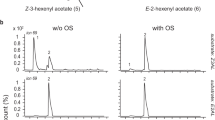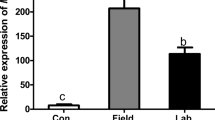Abstract
Caterpillar salivary glucose oxidase (GOX) can function as both an elicitor or as an effector of plant defense responses depending upon the system. Treatment with GOX reduces the stomatal aperture of tomato and soybean leaves, thereby reducing the emission of volatile organic compounds (VOCs), that are important indirect defense responses of plants by attracting natural enemies of the caterpillars. Here we examined the effect of fungal GOX (fungal glucose oxidases have been used to determine specificity in defense response elicitation) on stomatal closure of maize leaves and on the volatile emission pattern whole maize plants. We also used salivary gland homogenate from wild-type and CRISPR-Cas9 Helicoverpa zea mutants deficient in GOX activity to determine the effect caterpillar saliva with and without GOX had on maize volatile emission. Collecting volatiles at 2-hour intervals allowed us to examine the changes in emission over time. Fungal GOX reduced the stomatal aperture in maize leaves, which may have influenced the observed significant reduction in total green leaf volatile (GLV) emission. Furthermore, fungal GOX significantly increased the emission of several key terpenes: linalool, DMNT, and Z-β-farnesene from maize, while salivary gland homogenate from wild type (WT; GOX+) H. zea increased the emission of α-pinene, β-pinene, and ocimene compared to H. zea unable to synthesize GOX. This study addressed a significant knowledge gap about the effect of GOX on maize volatiles and provides a baseline for further research on the effect of GOX on the regulation of terpene synthase genes and their relation to terpene volatile emission.



Similar content being viewed by others
References
Acevedo FE, Rivera-Vega LJ, Chung SH, Ray S, Felton GW (2015) Cues from chewing insects—the intersection of DAMPs, HAMPs, MAMPs and effectors. Cur Op Plant Bio 26:80–86
Allison JD, Daniel Hare J (2009) Learned and naive natural enemy responses and the interpretation of volatile organic compounds as cues or signals. New Phyt 184(4):768–782
Allmann S, Baldwin IT (2010) Insects betray themselves in nature to predators by rapid isomerization of green leaf volatiles. Science 329(5995):1075–1078
Bede JC, Musser RO, Felton GW, Korth KL (2006) Caterpillar herbivory and salivary enzymes decrease transcript levels of Medicago truncatula genes encoding early enzymes in terpenoid biosynthesis. Plant Mol Bio 60(4):519–531
Bhattacharjee S (2005) Reactive oxygen species and oxidative burst: roles in stress, senescence and signal transduction in plants. Curr Sci 10:1113–1121
Block A, Vaughan MM, Christensen SA, Alborn HT, Tumlinson JH (2017) Elevated carbon dioxide reduces emission of herbivore-induced volatiles in Zea mays. Plant Cell & Envir 40(9):1725–1734
Büchel K, Malskies S, Mayer M, Fenning TM, Gershenzon J, Hilker M, Meiners T (2011) How plants give early herbivore alert: volatile terpenoids attract parasitoids to egg-infested elms. Basic Appl Ecol 12(5):403–412
De Lange ES, Laplanche D, Guo H, Xu W, Vlimant M, Erb M, Ton J and Turlings TC (2020) Spodoptera frugiperda caterpillars suppress herbivore-induced volatile emissions in maize. J Chem Ecol 46: 344-360
Delphia CM, Mescher MC, Felton G, Moraes CM (2006) The role of insect-derived cues in eliciting indirect plant defenses in tobacco, Nicotiana tabacum. Plant Sig & Behavior 1(5):243–250
Eichenseer H, Mathews MC, Bi JL, Murphy JB, Felton GW (1999) Salivary glucose oxidase: multifunctional roles for Helicoverpa zea? Arch Ins Biochem and Phys 42(1):99–109
Eichenseer H, Mathews MC, Powell JS, Felton GW (2010) Survey of a salivary effector in caterpillars: glucose oxidase variation and correlation with host range. J Chem Ecol 36(8):885–897
Engelberth J, Alborn HT, Schmelz EA, Tumlinson JH (2004) Airborne signals prime plants against insect herbivore attack. PNAS 101(6):1781–1785
Engelberth M, Selman SM, Engelberth J (2019) In-cold exposure to Z-3-hexenal provides protection against ongoing cold stress in Zea mays. Plants 8(6):165
Erb M, Veyrat N, Robert CA, Xu H, Frey M, Ton J, Turlings TC (2015) Indole is an essential herbivore-induced volatile priming signal in maize. Nat Comm 6(1):1–0
Felton GW, Tumlinson JH (2008) Plant–insect dialogs: complex interactions at the plant–insect interface. Curr Op Plant Bio 11(4):457–463
Frost CJ, Mescher MC, Carlson JE, De Moraes CM (2008) Plant defense priming against herbivores: getting ready for a different battle. Plant Phys 146(3):818–824
Harley PC (2013) The roles of Stomatal conductance and compound volatility in Controlling the Emission of Volatile Organic Compounds from Leaves. In: Niinemets Ü, Monson R (eds) Biology, Controls and Models of Tree Volatile Organic compound emissions. Tree Physiology, vol 5. Springer, Dordrecht, pp 181–208
Hilker M, Fatouros NE (2015) Plant responses to insect egg deposition. Ann Rev Ent 60:493–515
Hu YH, Leung DW, Kang L, Wang CZ (2008) Diet factors responsible for the change of the glucose oxidase activity in labial salivary glands of Helicoverpa armigera. Arch Insect Biochem Phys 68(2):113–121
Jones AC, Seidl-Adams I, Engelberth J, Hunter CT, Alborn H, Tumlinson JH (2019) Herbivorous caterpillars can utilize three mechanisms to alter green leaf volatile emission. Env Ent 48(2):419–425
Jones AC, Felton GW, Tumlinson JH (2021) The dual function of elicitors and effectors from insects: reviewing the ‘arms race’ against plant defenses. Plant Mol Bio 7:1–9
Karban R (2021) Plant communication. Annu Rev Ecol Evol Syst 52:1–24
Lin PA, Peiffer M, Felton GW (2020) Induction of defensive proteins in Solanaceae by salivary glucose oxidase of Helicoverpa zea caterpillars and consequences for larval performance. Arth-plant Inter 14(3):317–325
Lin PA, Chen Y, Chaverra-Rodriguez D, Heu CC, Zainuddin NB, Sidhu JS, Peiffer M, Tan CW, Helms A, Kim D, Ali J (2021) Silencing the alarm: an insect salivary enzyme closes plant stomata and inhibits volatile release. New Phyt 230(2):793–803
Lin PA, Chen Y, Ponce G, Acevedo FE, Lynch JP, Anderson CT, Ali JG, Felton GW (2022a) Stomata-mediated interactions between plants, herbivores, and the environment. Trends in Plant Sci 27(3):287–300
Lin YH, Silven J, Wybouw N, Fandino R, Dekker H, Vogel H, Wu YL, de Koster C, Große-Wilde E, Haring M, Schuurink R (2022b) A salivary GMC oxidoreductase of Manduca sexta re-arranges the green leaf volatile profile of its host plant. https://doi.org/10.21203/rs.3.rs-1558711/v1
Liu D, Li W, An X, Ghasemzadeh S, Huang X, Chen J, Kou J, Sun P, Zhang Y (2021) Engineering Nicotiana tabacum for the de novo biosynthesis of DMNT to regulate orientation behavior of the parasitoid wasps Microplitis mediator. Pest Man Sci 77(1):502-9
Louis J, Peiffer M, Ray S, Luthe DS, Felton GW (2013) Host-specific salivary elicitor (s) of european corn borer induce defenses in tomato and maize. New Phyt 199(1):66–73
Low PS, Merida JR (1996) The oxidative burst in plant defense: function and signal transduction. Physiol Plant 96(3):533–542
Matsui K, Engelberth J (2022) Green leaf volatiles—the forefront of plant responses against biotic attack. Plant and Cell Phys 63(10):1378–1390
Matsui K, Koeduka T (2016) Green leaf volatiles in plant signaling and response. In: Nakamura Y, Li-Beisson Y (eds) Lipids in plant and algae development. Springer International Publishing, Switzerland, pp 427–443
Merkx-Jacques M, Bede JC (2005) Influence of diet on the larval beet armyworm, Spodoptera exigua, glucose oxidase activity. J Ins Sci 5(1)
Musser RO, Hum-Musser SM, Eichenseer H, Peiffer M, Ervin G, Murphy JB, Felton GW (2002) Caterpillar saliva beats plant defences. Nature 416(6881):599–600
Musser RO, Cipollini DF, Hum-Musser SM, Williams SA, Brown JK, Felton GW (2005) Evidence that the caterpillar salivary enzyme glucose oxidase provides herbivore offense in solanaceous plants. Arch Ins Biochem and Phys 58(2):128–137
Nemecek-Marshall M, MacDonald RC, Franzen JJ, Wojciechowski CL, Fall R (1995) Methanol emission from leaves (enzymatic detection of gas-phase methanol and relation of methanol fluxes to stomatal conductance and leaf development). Plant Phys 108(4):1359–1368
Niinemets U, Reichstein M, Staudt M, Seufert G, Tenhunen JD (2002) Stomatal constraints may affect emission of oxygenated monoterpenoids from the foliage of Pinus pinea. Plant Phys 130(3):1371–1385
Peiffer M, Felton GW (2005) The host plant as a factor in the synthesis and secretion of salivary glucose oxidase in larval Helicoverpa zea. Arch Ins Biochem and Phys 58(2):106–113
Quan LJ, Zhang B, Shi WW, Li HY (2008) Hydrogen peroxide in plants: a versatile molecule of the reactive oxygen species network. J Int Plant Bio 50(1):2–18
Ramírez CC, Restrepo-Díaz H (2022) Influence of Drought, high temperatures, and/or defense against Arthropod Herbivory on the production of secondary metabolites in Maize plants. A review. Curr Plant Bio 21:100268
Richter A, Seidl-Adams I, Köllner TG, Schaff C, Tumlinson JH, Degenhardt J (2015) A small, differentially regulated family of farnesyl diphosphate synthases in maize (Zea mays) provides farnesyl diphosphate for the biosynthesis of herbivore-induced sesquiterpenes. Planta 241(6):1351–1361
Rivera-Vega LJ, Acevedo FE, Felton GW (2017) Genomics of Lepidoptera saliva reveals function in herbivory. Cur Op Insect Sci 19:61–69
Saxena I, Srikanth S, Chen Z (2016) Cross talk between H2O2 and interacting signal molecules under plant stress response. Front Plant Sci 7:570
Scala A, Allmann S, Mirabella R, Haring MA, Schuurink RC (2013) Green leaf volatiles: a plant’s multifunctional weapon against herbivores and pathogens. Int J Mol Sci 14(9):17781–17811
Sobhy IS, Erb M, Turlings TC (2015) Plant strengtheners enhance parasitoid attraction to herbivore-damaged cotton via qualitative and quantitative changes in induced volatiles. Pest Man Sci 71(5):686–693
Takai H, Ozawa R, Takabayashi J, Fujii S, Arai K, Ichiki RT, Koeduka T, Dohra H, Ohnishi T, Taketazu S, Kobayashi J (2018) Silkworms suppress the release of green leaf volatiles by mulberry leaves with an enzyme from their spinnerets. Sci Rep 8(1):1–4
Takemoto H, Powell W, Pickett J, Kainoh Y, Takabayashi J (2012) Two-step learning involved in acquiring olfactory preferences for plant volatiles by parasitic wasps. Anim Behav 83(6):1491–1496
Tang Q, Hu Y, Kang L, Wang CZ (2012) Characterization of glucose-induced glucose oxidase gene and protein expression in Helicoverpa armigera larvae. Arch Biochem and Phys 79(2):104–119
Tian D, Peiffer M, Shoemaker E, Tooker J, Haubruge E, Francis F, Luthe DS, Felton GW (2012) Salivary glucose oxidase from caterpillars mediates the induction of rapid and delayed-induced defenses in the tomato plant. PLoS ONE 7(4):e36168
Turlings TC, Tumlinson JH, Lewis WJ (1990) Exploitation of herbivore-induced plant odors by host-seeking parasitic wasps. Science 250(4985):1251–1253
Yan ZG, Wang CZ (2006) Identification of Mythmna separata-induced maize volatile synomones that attract the parasitoid Campoletis chlorideae. J App Ent 130(4):213–219
Yang L, Wang X, Bai S, Li X, Gu S, Wang CZ, Li X (2017) Expressional divergence of insect GOX genes: from specialist to generalist glucose oxidase. J Ins Phys 100:21–27
Zhang L, Li D, Yao Y, Zhang S (2020) H2O2, Ca2+, and K + in subsidiary cells of maize leaves are involved in regulatory signaling of stomatal movement. Plant Phys and Biochem 152:243–251
Acknowledgements
The authors would like to thank the former Tumlinson lab for use of plant volatile collection equipment, GC-FID, and GC-MS instrumentation for compound analysis.
Funding
This work was support by the National Science Foundtation (No. IOS – 1645331).
Author information
Authors and Affiliations
Contributions
Material preparation, data collection and analysis were performed by A. J. and M. P. CRISPR-Cas GOX mutant insects were developed by P. L. The first draft of the manuscript was written by A. J. and all authors commented on previous version of the manuscript. All authors read and approved the final manuscript.
Corresponding author
Ethics declarations
Competing Interests
The authors declare no competing interests.
Additional information
Publisher’s Note
Springer Nature remains neutral with regard to jurisdictional claims in published maps and institutional affiliations.
Electronic Supplementary Material
Below is the link to the electronic supplementary material.
Rights and permissions
Springer Nature or its licensor (e.g. a society or other partner) holds exclusive rights to this article under a publishing agreement with the author(s) or other rightsholder(s); author self-archiving of the accepted manuscript version of this article is solely governed by the terms of such publishing agreement and applicable law.
About this article
Cite this article
Jones, A.C., Lin, PA., Peiffer, M. et al. Caterpillar Salivary Glucose Oxidase Decreases Green Leaf Volatile Emission and Increases Terpene Emission from Maize. J Chem Ecol 49, 518–527 (2023). https://doi.org/10.1007/s10886-023-01440-3
Received:
Revised:
Accepted:
Published:
Issue Date:
DOI: https://doi.org/10.1007/s10886-023-01440-3




